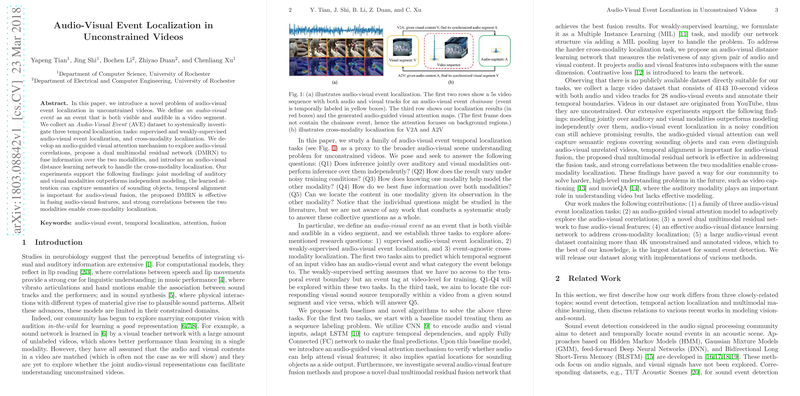Audio-Visual Event Localization in Unconstrained Videos: A Comprehensive Study
The paper "Audio-Visual Event Localization in Unconstrained Videos" explores the synergistic potential of integrating auditory and visual information for event localization tasks in videos. The authors present a compelling argument for leveraging both modalities to enhance understanding and performance in temporal localization tasks.
The paper explores three specific tasks: supervised and weakly-supervised audio-visual event localization, and cross-modality localization. The authors introduce a novel audio-guided visual attention mechanism to harness the inherent correlations between audio and video modalities. This is complemented by a dual multimodal residual network (DMRN) designed to effectively fuse audio-visual information, and an audio-visual distance learning network geared towards cross-modality localization.
The research is underpinned by rigorous experimentation, demonstrating that joint modeling of auditory and visual modalities yields superior results compared to independent modeling. For instance, attention mechanisms in the paper successfully capture semantic details of sound-producing objects, and the DMRN exhibits efficacy in feature fusion tasks. The paper asserts the significance of temporal alignment in audio-visual fusion, a critical insight for developing more cohesive integration strategies.
A noteworthy contribution of the paper is the introduction of the Audio-Visual Event (AVE) dataset, which consists of over 4,000 10-second annotated videos, highlighting audio-visual events. This dataset is pivotal for the tasks explored and is claimed to be the largest of its kind for sound event detection.
The supervised and weakly-supervised tasks are evaluated using overall accuracy, with joint audio-visual representations consistently outperforming single-modality frameworks. The inclusion of a weakly-supervised approach demonstrates the potential for effective learning even under noisy conditions. Similarly, the cross-modality localization task, evaluated by the accuracy of matched segments, reinforces the strong correlations between audio and visual data.
Overall, this paper provides a comprehensive framework that not only advances audio-visual event localization but also opens avenues for addressing more complex questions in video understanding, such as video captioning and video-based question answering. The methodologies and dataset proposed are valuable resources for future research endeavors in multimedia and artificial intelligence.
In summary, this paper makes significant strides in the field of audio-visual event localization, offering robust methodologies and insights that could inform future studies and applications within the field of computational media analysis.
